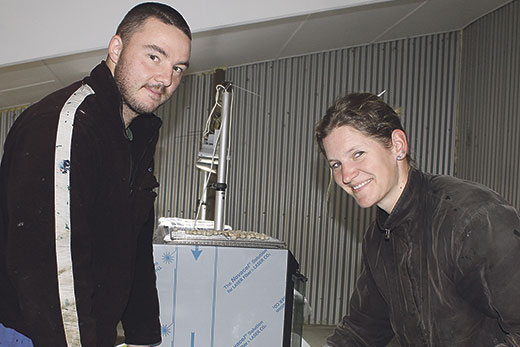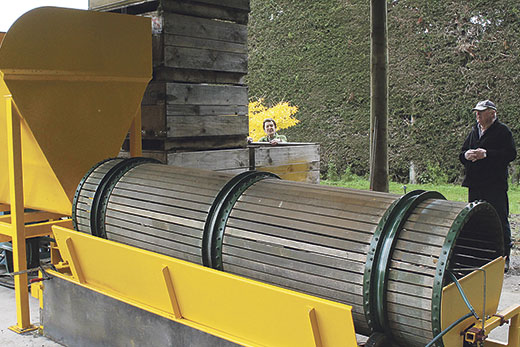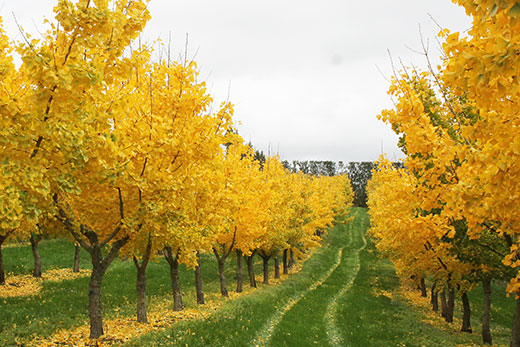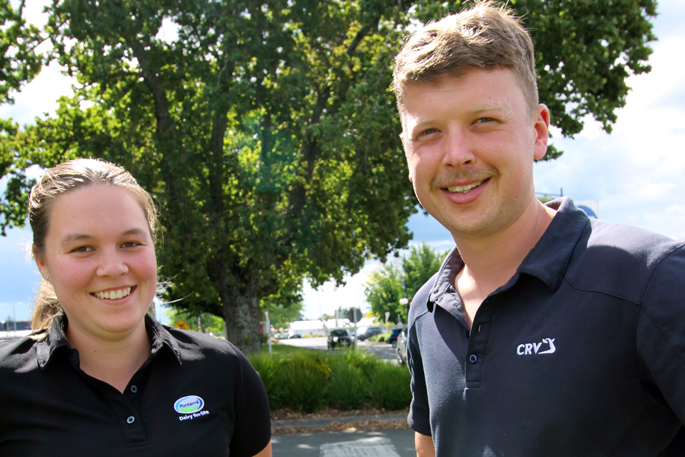Ginkgo is an attractive specimen tree, especially in autumn when its fan-shaped leaves turn bright yellow.
But it’s the popularity of the fruit of ginkgo growing in urban parks and streets which got Mavis and Graham Dyer questioning whether there were other possibilities in New Zealand for the ancient species.
“We had noticed that in autumn the fruit of virtually every female tree growing in public places is harvested by local Asian people, who obviously value the nuts,” says Graham.
The couple’s research revealed the ginkgo, a tree species which evolved before insects and relies on wind pollination, produces nuts which are a delicacy in China, Japan and the Korean Peninsula.

Pavel Hohn and Eva Oharkova, who probably know more about ginkgo growing than anyone else in NZ, may have to leave the country now their visas have expired.
The nuts are used in cooking, often as part of special celebratory meals, and are believed to have a range of beneficial effects including improved circulation, cogitative function and even increasing life expectancy.
Two-thousand trees
The potential to grow the nuts commercially in New Zealand for the local market, and produce an out-of-season crop for Northern Hemisphere consumers, appealed to the Dyer’s entrepreneurial nature. So they set about establishing an orchard of the trees.
Today the couple have 2000 ginkgo biloba trees growing on their Bay Park Orchard in the Kaimai Range, in two blocks alongside green and gold kiwifruit and an arboretum of specimen kauri trees from around the Pacific.
Mavis grafted the first trees, using New Zealand bud wood, but they failed to produce nuts which were big enough to sell commercially.
The couple’s research took them to Japan, where they sourced graft wood of two varieties that Mavis re-grafted onto the existing root stock 10 years ago.
Only the female trees produce fruit, and they are slow to mature – so for years the trees have been carefully tended, pruned and fertilised in anticipation of their first crops.
“Because no one grows ginkgo commercially in New Zealand, and not on this scale, we’ve had to research everything we can and then find ways to adapt that information to fit our operation,” says Graham.
Losing valuable skills
They’ve been helped in their research by Ryoto Eguchi of Japan, Eva Oharkova, and New Zealand post-harvest scientist Dr Nigel Banks to name a few. Pavel Hohn and Eva, from the Czech Republic, have for the last four years have worked on the orchard.
“Pavel and Eva probably know more about how to grow ginkgo commercially than anyone else in New Zealand but unfortunately their work visas have expired and they don’t have enough points to qualify for residency so will be returning home – and we will be losing their valuable skills,” says Graham.
This season the Dyers have harvested enough nuts to send samples to prospective purchasers in Auckland, but the trials and tribulations of growing ginkgo commercially continue.
“In Japan ginkgo are grown on a very small scale with about 20 trees to an orchard,” says Graham.
“In Japan it is usually the grandmother who harvests the fruit from the ground, picking them up to wash, clean and put into punnets.
“With 2000 trees on our orchard, this grandmother wasn’t about to do that,” says Mavis.
Apple harvester
So the couple imported a self-propelled, modified apple harvester from Germany, which is used to pick up windfall apples from the ground for making cider.
It’s proved reasonably successful at picking up the small fleshy ginkgo fruit from the ground, once a smooth enough surface to operate on was provided. “It doesn’t work well if the ground isn’t flat so we had to take off some humps and fill in some hollows,” says Mavis.

A carrot washer has been modified to clean ginkgo nuts on Mavis and Graham Dyer’s orchard.
The harvested fruit is left in picking bins for the flesh to ferment, then it is tipped into a hopper with an auger, which removes some of the flesh, before being passed into a revolving, wooden slatted drum, where the remaining flesh is removed by a high pressure waterblaster.
This process is another example of the Dyer’s ingenuity in taking ideas from other industries to fit the peculiar requirements of ginkgo post-harvest operations. The barrel and washing system is based on a carrot washing processes.
Once washed clean the nuts are graded, washed once again to keep them food safe, graded and carefully dried before packing into punnets ready for sale as fresh nuts.
Right temperature
This step is carried out in a converted cowshed, where a temporary stainless steel grading table and overhead lights have been set up. “Once we figure out what works, we’ll install permanent facilities and have the building certified as a food handling facility,” says Graham.
Imported ginkgo nuts which have been cooked are on sale in New Zealand, but the Dyers hope their fresh nuts will appeal to Asian consumers and restaurant chefs.
“We are still experimenting to find out the right temperature and time to dry the nuts so they are an attractive white colour, but not cooked,” says Mavis.
The nuts need to be kept refrigerated and among the trials being carried out are those to determine the best kind of packaging and storage conditions to extend their shelf life.
Mavis says while anecdotally ginkgo have many health benefits, they shouldn’t be eaten by anyone taking blood thinning medication without medical advice because they may thin blood even further. Pregnant and breastfeeding women should not eat ginkgo nuts.
The ginkgo orchard is yet another example of the Dyer’s pioneering ventures. In 2011, when Mavis and Graham won the supreme award in the Bay of Plenty Ballance Farm Environment Awards, judges commented on the fact they had pioneered the successful production of green and gold kiwifruit cultivars at higher altitude, with twice the rainfall and lower sunshine hours than Tauranga, through careful management of the soil, including nutrients, fruit canopy and the capturing of water for frost control.




0 Comments
Leave a Comment